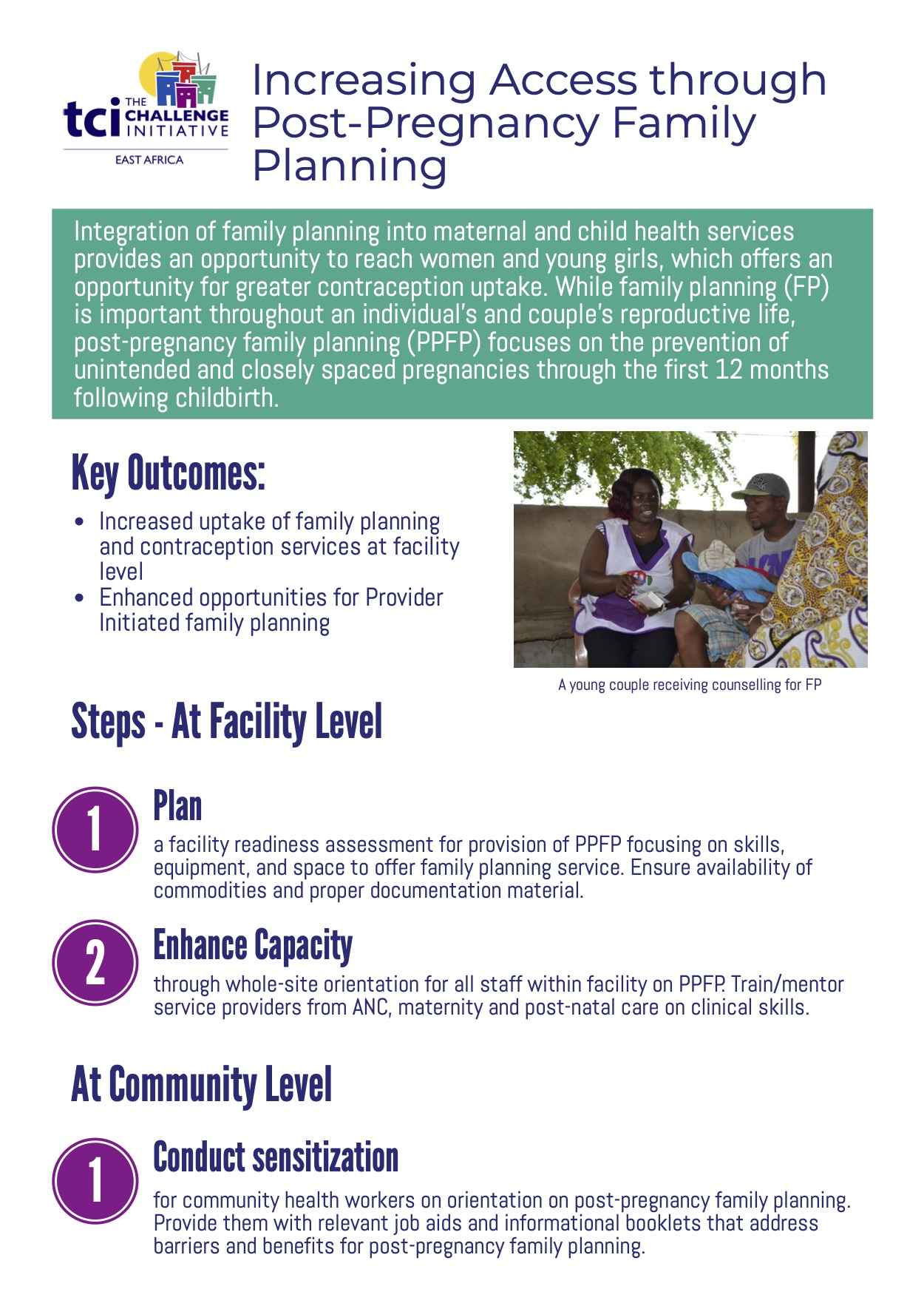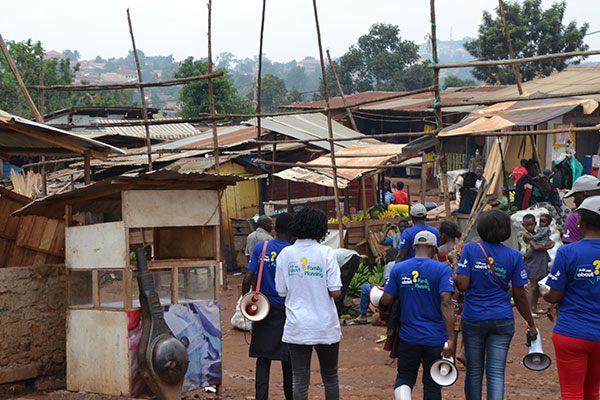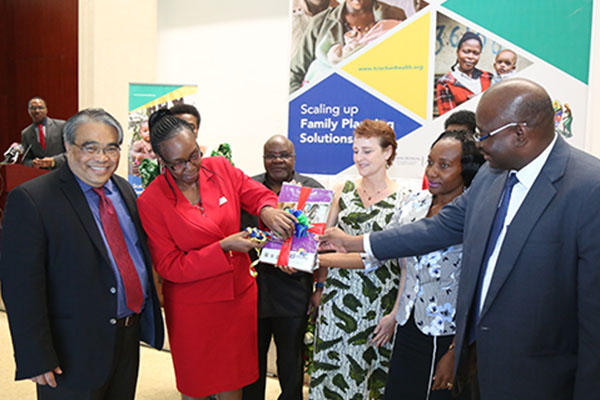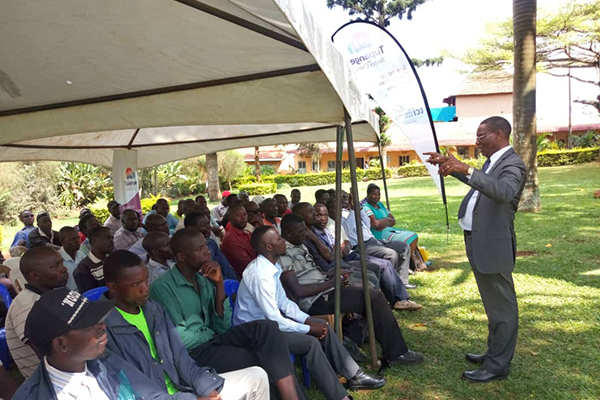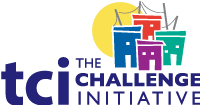East Africa Toolkit: Services and Supply
- Home
- Help and Support
- Close
- Toolkits
- Global Toolkit
- AYSRH Toolkit
- Hub Toolkits
- Core High-Impact Practices
- Gender Essentials Mini Course
- Close
- Resource Collection
- Community of Practice
- Coaching
- Log In/Register
- My Profile
- English
Post-Pregnancy Family Planning
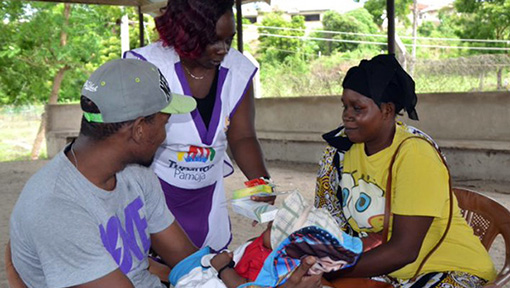 Post-pregnancy family planning (PPFP) is defined as the prevention of unintended pregnancies and closely spaced pregnancies through the first 12 months after childbirth, but it can apply to an “extended” postpartum period up to two years following childbirth (WHO 2018).
Post-pregnancy family planning (PPFP) is defined as the prevention of unintended pregnancies and closely spaced pregnancies through the first 12 months after childbirth, but it can apply to an “extended” postpartum period up to two years following childbirth (WHO 2018).
Providing family planning counseling as part of childbirth care raises awareness of the importance of birth spacing and postpartum contraceptive options. Family planning may be provided:
- Immediately postpartum (IPPFP) – within 48 hours
- During early postpartum (EPPFP) – 48 hours up to 6 weeks
- Including extended postpartum (EPPFP) – 6 weeks to one year after delivery
- Post-abortion
This proven intervention is intended to help programs implement PPFP at the facility and community level.
Why Post-Pregnancy Family Planning (PPFP) Is Important
PPFP has an important role to play as an evidence-based strategy to reduce the unmet need for family planning. The rationale for PPFP is postpartum women are among those with the greatest unmet need for FP. According to an analysis of Demographic and Health Surveys (DHS) data from eight sub-Saharan countries, 95% of women who are 0–12 months postpartum want to avoid a pregnancy in the next 24 months. As a result, World Health Organization (WHO) has expanded immediate PPFP methods to include contraceptive Implants, pills and levonogestrel IUDs.
Evidence
- Research has demonstrated that more than 90% of women during their first year postpartum want to either delay the next pregnancy for at least two years or avoid future pregnancies all together.
- Women are much more likely to take up postpartum family planning if they have made a decision before going into labor.
- Pregnancies in the postpartum period pose the greatest risk for women and their infants and have increased risks of adverse health outcomes (WHO 2018).
Guidance on how to implement PPFP
At facility level
- Carry out a facility readiness assessment for provision of PPFP, focusing on skills, equipment, and space to offer family planning service. Ensure availability of commodities and proper documentation.
- Conduct whole-site orientation, including lessons on PPFP, for all staff within facility to rally the needed support for service reorganization, appropriate mobilization of clients and documentation.
- Train/mentor service providers from antenatal care (ANC), maternity, postnatal care (PNC), and post-abortion care (PAC) on clinical skills.
- Update the commodity management system to capture commodities provided in all other service areas outside family planning unit/room. Define the flow of FP commodities within the facility – e.g., Is it from the family planning unit/room or the central stores where the other departments will order their commodities?
- Distribute family planning equipment to maternity/postnatal ward (PNW) and Gynae ward for implant and postpartum IUD insertion:
- Kelly forceps 32 centimeters
- Sims speculum: 1 large and 1 medium
- Sponge
- Holding forceps
- Kidney dish
- Gallipot
- Print the instructional aid for PPFP to remind providers about counseling and provision of PPFP.
- Document Immediate PPFP uptake data. Provide a family planning register in all service delivery points (PNC, PAC, etc.).
- Identify a facility PPFP champion whose responsibility is to ensure routine provision of immediate PPFP.
- Conduct monthly facility review meetings on immediate PPFP to strengthen the quality of services through:
- Review of FP service statistics data to evaluate performance, and
- Address barriers to provision of immediate PPFP services.
At Antenatal Care
- Counsel women on their PPFP options at every ANC visit.
- During the last trimester visit, review the birth preparedness plan and prepare a PPFP plan, which includes the place of delivery and the method chosen.
At Maternity / Postnatal Ward
Reorganize services to establish immediate PPFP service provision. Use the following steps as a guide:
- Allocate a room or space in maternity/PNW to provide immediate PPFP.
- Update the commodity management system to capture commodities provided in all other service areas outside the family planning unit/room. Define the flow of FP commodity within the facility – e.g., Is it from family planning unit/room or the central stores that the other departments will order their commodities from?
- Distribute family planning equipment to maternity/PNW, Gynae ward. This includes implant insertion and PPIUD insertion sets, Kelly forceps 32cms, sims speculum (1 large ,1 medium), sponge holding forceps, kidney dish and gallipot.
- Print the instructional aid for PPFP to remind providers about counseling and provision of immediate PPFP.
- Document Immediate PPFP uptake data. Provide a family planning register in all service delivery points e.g., PNC, PAC, etc.
At Routine Postnatal Care
- Counsel women on PPFP options at every visit.
At Gynae ward
- After they receive care, counsel women who have come for non-FP services and procedures on PPFP and provide service.
- Distribute FP equipment and commodities.
At Community level
In conjunction with Community Health Extension Workers/Community Health Volunteers/Villages Health Teams (CHEW/CHV/VHT):
- Conduct orientation on PPFP.
- Provide VHTs/CHVs/CHEWs with job aids/IEC materials, myths and misconception booklets.
- Conduct progress review meetings on PPFP to address any barriers to provision of PPFP services and other support needed.
Useful Tips
- During ANC counseling, service providers should be encouraged to counsel clients on family planning options and document this counseling.
- Provide IEC materials, such as posters with PPFP messages, posted in maternity/PNW, Gynae ward and MCH.
- Consider home visits if targeting PPFP adoption among first time, young parents.
- If MOH registers do not already capture Immediate PPFP data elements, provide alternative tools for data capture.
Key Outcomes for PPFP
- Increased uptake of family planning and contraception services at facility level
- Enhanced opportunities for provider-initiated family planning
Monitoring Processes
- Monitor provision of immediate post-pregnancy FP through service statistics on a monthly basis.
- Routinely assess the quality of PPFP service provision against global/national guidelines.
- At least monthly, provide supportive supervision to review PPFP services and data.
Success Indicators
- Number of women who select a method during ANC and are eligible who receive desired method prior to discharge
- Increased number of women who deliver and go home with a FP method
- Increased number of women counseled on a FP method
- Increase in competent health care workers providing PPFP services
- Expanded method mix for immediate PPFP to include implants, progestin only pills and IUDs
- All pregnant women within households reached with PPFP information by CHVs/CHEWs/VHTs
Cost
- Facility readiness assessment
- Training of health care workers at facilities implementing PPFP
- Training of CHWs/CHEWs/VHTs to implement PPFP at community level
- Printing of PPFP tools (referrals, registers, summary tools at facility and community level)
- Supportive supervision of PPFP activities
- Cascade whole site orientation to other facilities; mentor/train providers
- PPFP guidelines dissemination
- PPFP IEC printing
- Follow-up visits/home visits
- PPFP landscaping and desk review by data clerk in consultation with Reproductive Health Coordinator
- PPFP equipment purchase
Sustainability
- Integrate concepts of PPFP within facility mentorship programs and ensure that PPFP and healthy timing and spacing of pregnancy (HTSP) are well-covered in practical training
- Integration of FP services within Maternal Newborn and Child services
TCI APP USERS PLEASE NOTE
You will only receive CERTIFICATES by email – when earning a score above 80% – and will not be able to view or print a certificate PDF from the TCI app.
Test Your Knowledge
Earn a Certificate
Quiz Summary
0 of 6 Questions completed
Questions:
Information
You have already completed the quiz before. Hence you can not start it again.
Quiz is loading…
You must sign in or sign up to start the quiz.
You must first complete the following:
Results
Results
0 of 6 Questions answered correctly
Your time:
Time has elapsed
You have reached 0 of 0 point(s), (0)
Earned Point(s): 0 of 0, (0)
0 Essay(s) Pending (Possible Point(s): 0)
Categories
- Not categorized 0%
- 1
- 2
- 3
- 4
- 5
- 6
- Current
- Review
- Answered
- Correct
- Incorrect
-
Question 1 of 6
1. Question
Post-pregnancy family planning (PPFP) is defined as the prevention of unintended pregnancies and closely spaced pregnancies through the first 12 months after childbirth.
CorrectIncorrect -
Question 2 of 6
2. Question
According to DHS Surveys from eight sub-Saharan countries, what percent of women who are 0-12 months post-partum want to avoid another pregnancy in the next 24 months?
CorrectIncorrect -
Question 3 of 6
3. Question
Women are more likely to take up post-pregnancy family planning if they have made the decision before going into labor.
CorrectIncorrect -
Question 4 of 6
4. Question
Steps in implementation of PPFP include:
CorrectIncorrect -
Question 5 of 6
5. Question
How useful did you find the information and/or tools presented on this page? Please write your response in the box below using one of the following phrases: Very useful, Useful, Somewhat useful, Not useful.
Feel free to comment on why you made that choice.
-
This response will be awarded full points automatically, but it can be reviewed and adjusted after submission.
Grading can be reviewed and adjusted.Grading can be reviewed and adjusted. -
-
Question 6 of 6
6. Question
How do you intend to use the information reviewed and/or tools that you accessed?
-
This response will be awarded full points automatically, but it can be reviewed and adjusted after submission.
Grading can be reviewed and adjusted.Grading can be reviewed and adjusted. -
External Resources
- Family Planning: A Global Handbook for Providers, WHO
- Programming Strategies for Postpartum Family Planning, WHO
- Immediate Postpartum Family Planning, HIPs


